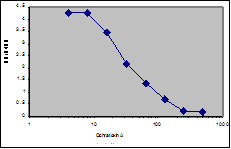聯(lián)系我們
電 話:0771-2310996
傳 真:0771-2310995
E-mail : 735565094@qq.com
技術(shù)支持E-mail: immunechem@gmail.com 備案號(hào):桂ICP備09007987號(hào)
地 址:廣西南寧市高新技術(shù)開(kāi)發(fā)區(qū)科園大道68號(hào)東盟慧谷11棟203室 530007
|
Catalog# Product Description |
ICP9947 This antibody was developed using ochratoxin A (OA)-KLH conjugates, linked via its free carboxyl group. The antibody was affinity purified with an OA-agarose affinity column. The purified antibody was chemically conjugated to HRP. It could be utilized for direct competitive detection and quantization of the food-borne mycotoxin, ochratoxin A. |
|

Direct competitive inhibition ELISA using immobilized anti-OA (1.5 μg/mL), and OA-labelled HRP (50 ng/mL). 50% inhibition occurred at 25 ng/mL of free ochratoxin A in non-optimized conditions.
|
|
Species
|
Rabbit
|
||
|
Formulation
|
0.25 mg/mL in stabilizing buffer
|
||
|
Immunogen
|
Pure ochratoxin A linked to KLH, via the free carboxyl group of OA using the NHS-active ester method.
|
||
|
Purification
|
Antigen-specific affinity chromatography
|
||
|
Specificity
|
The antibody recognizes ochratoxin A (100%), C (400%), B (5%), and <1% of ochratoxin alpha.
|
||
|
Applications
|
ELISA, affinity column enrichment
Note: For better ELISA results, use a different method than the NHS-active ester method to prepare the paired antigen, such as the OA-OV with EDC method.
|
||
|
Scientific Description
|
Ochratoxin A is a food borne mycotoxin which is carcinogenic and nephropathic to both humans and animals. Contamination with OA in food may be harmful to humans and animals.
|
||
|
Storage & Stability
|
Product is stable for several weeks at 4°C. For extended storage, store product at -20°C. Expiration date issix months from date of shipping if stored properly.
|
||
|
Product Specific References |
|